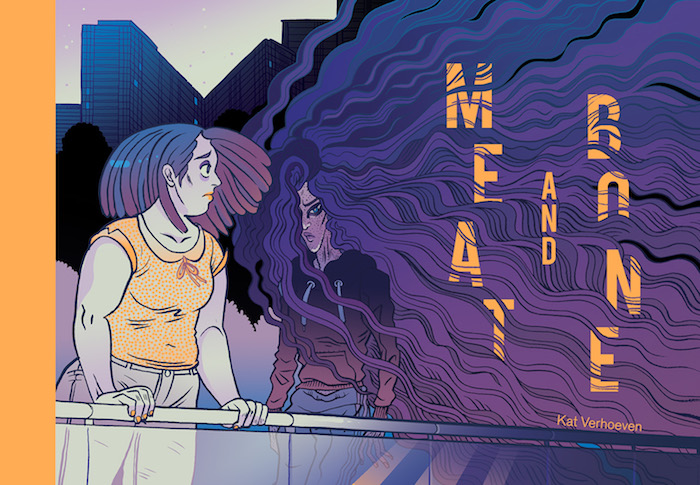I first fell in love with indie and alternative comics because they told the stories I was craving. Before I could even articulate why I needed to see queer people on the page, I would obsessively seek out artists who were creating characters missing from the mainstream. When I stumbled on Meat & Bone several months back, I felt that now-familiar sense of excitement that comes with discovering a truly unique story. Here were complicated characters that I had not seen anywhere else before, having eerie dreams fueled by negative body image and exploring unconventional relationships.
Meat & Bone’s creator, Kat Verhoeven, graciously took time to chat with me over Skype about putting pieces of her life into her characters, poetry comics, and Jane Fonda.
What first inspired you to create Meat & Bone?
I’d just started doing mini comics I think that year, and I knew I wanted to work on a longer project. I’ve done some autobio stuff before, but it doesn’t really work for me. I don’t feel like I’m very good at [making it] engaging enough for a long form story. I still want to tell my own experience, having had an eating disorder and constantly struggling with body image. I hadn’t seen any comics like that before, so I re-told my story through a narrative lens with additional characters and some more interesting plot stuff, to make it more fun for me to write. I wanted to have a long form comic; a webcomic seemed like a great way to put it out there and tell my story.
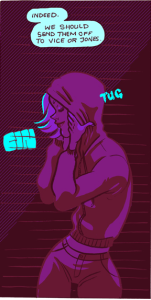
I haven’t seen a comic that talks about eating disorders, either. Also, the polyamory is really unique; I’ve only seen bits of it in autobio comics.
There’s one other comic about eating disorders that I know is out there (Lighter Than My Shadow, which began as a webcomic and is now a book), and there’s another comic that’s specifically about a polyamorous triad having a baby. That’s called The Feeling is Multiplied. It’s pretty cute; it’s got sort of an Erika Moen feel to it. Other than that, I know a lot of game makers and comic makers who will talk about their relationships a little, but there’s not a lot of people writing those stories. I know Valerie Halla, who does Goodbye to Halos, might be heading in that direction, but it’s too soon to say.
On polyamory, I wanted to talk about the specific relationships in the comic, because it’s so focused on relationships: friendships, romantic relationships, and relationships with food. It’s interesting to see Gwen, who is figuring things out and also making terrible mistakes, versus Ryan, who is very chill and comfortable in his polyamory and bisexuality.
When I was starting to write Meat & Bone I was experimenting with my own polyamory, and how I wanted to handle my relationships. I never screwed up like [Gwen] did, but I like characters who mess up a lot and are super self-aware in some ways and really clueless in other ways. I think that’s an interesting dynamic, so I wanted her to have that combination of being this really smart, driven woman, who’s still very capable of making serious errors by getting swept along by her own passions.
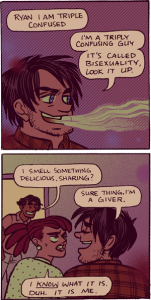
Ryan is an old character who I feel really close to. In some ways he’s a bit too idealistic. He’s very sage-like, he’s super comfortable, but he does have his own issues. He has some insecurity about people staying with him, which is not something that’s been seen yet because he’s a secondary character. Meat & Bone does have a set ending, and I definitely want the focus to be more on the female characters, but I think the fact that I love Ryan so much comes through. He’s fun; he gets to joke and gets to make things a little bit easier when things get heavy, because he doesn’t take anything seriously. But sometimes he doesn’t take things seriously when he should.
It’s interesting to watch Anne spiraling now, but in the beginning of the comic there was a lot of thin-is-pretty rhetoric. Like Jane Fonda, the Jane Fonda obsession, and the really eerie Jane Fonda dreams.
There will be a couple more! Jane Fonda as a person is super interesting, and I read this book she had—it’s actually the book that’s in the comic—and she talks a lot about her own eating disorder. Reading that helped me write Meat & Bone, which is kind of why she’s included. Jane Fonda’s not exactly a modern reference.
[Anne and Marshall] are the crux relationship of the story. It is about the roommates, but it’s mostly about Anne and Marshall, who are each other’s balancing point in a lot of ways. It’s about how they’re good for each other or bad for each other. It’s a lot about co-dependency, which is purposefully metaphorical in terms of the body image theme of the whole comic.
For Anne, it seems like there are two pieces [to her body image issues]. There are other influences or people in her life that pushed her to feel like she needs to look a certain way. Then, there is recognizing Marshall’s anorexic and being like, I’m going to let you into my life and bring this into my life. There is and isn’t choice.
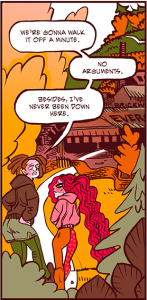
In my experience, if I was going to do something that was bad for me, it was always a choice, but sometimes it wasn’t a choice that I had a choice about. That’s a weird way to put it, but you can be aware of the things that are influencing you and be aware that you adopt harmful behaviors. But, if you’re going to do something—like all the diet stuff that Anne is doing—that is still a choice. It’s almost a compulsive choice. Choosing to be friends with Marshall is a choice, but it’s also a reflection of a lot of self-worth issues and problems that Anne has.
And Anne is attracted to Marshall, so that takes some of the choice out of it.
Yeah, there’s this whole aspect of, does she like-like her? Does she like how she looks and want to be that? What is the exact nature of the like? It’s really layered, but Anne, especially being a bisexual woman who’s come out of a long-term relationship with a man, is re-addressing, “Well, I know I’m attracted to women but it’s been a long time, so am I sure about that?” So that’s something going on in her head that comes up.
I find that happens. If you’ve been apparently heterosexual for a long time, but you’re not actually, society has viewed you in this way and accepted you like that, and you’ve gone along with it. Coming out of that is a reassessment, sometimes.
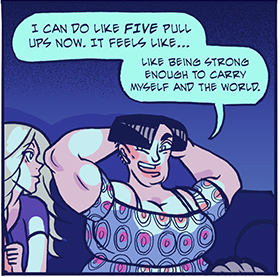 I love Jane’s storyline, especially as she’s getting really into weightlifting and getting obsessed with it—well, I don’t know if [calling it obsession] is fair.
I love Jane’s storyline, especially as she’s getting really into weightlifting and getting obsessed with it—well, I don’t know if [calling it obsession] is fair.
I think it’s healthy obsession. Passion—that would be the word, like, wow, this makes me feel great about myself. When I started this comic, I was usually writing with a month-to-two-months leeway. I was right ahead of where I was drawing. Now, I’ve completed the script, but [initially] I was planning all three roommates to have really intense negative sides to these choices they were making. Each has their theme or their topic that I’m exploring, but as I wrote Jane’s theme I was like, this is just really positive. This makes me feel positive for the character that she is, and the relationship she has. She doesn’t get that negative thing as much as the other characters do. She sort of lifts herself up with it; she’s not drowning herself. She’s building herself in every sense of the word.
The colors, especially right now, are gorgeous. I’m not familiar with any of the places [in Toronto], but I wanted to ask you about your style, and how you go about coloring Meat & Bone. It’s really cool to look at the archive; you can see where scenes change because the whole color scheme changes.
You might also notice, I think for the first fifty pages or so, that it’s all one color scheme. [That’s] because I was planning on doing the entire comic this one color scheme the whole way through. I just got sick of it, so I threw it out the window. Someday I would like to do a print collection, and I’m going to have to go back and re-tool all those pages so they have the same artistic feel as the rest of the story.
Sometimes the colors are based on how much time I have. Right now I’m doing pretty full-colored ones. There’s a few pages [that] wind up being more successful with a really limited pallet. I like to set the tone and mood and show what time of day it is, but mostly I’m just trying to make something that I like looking at. That’s my first goal.
The scene that’s going on right now, which is Anne and Marshall going for a run down by the Evergreen Brick Works, that’s a pretty heavy conversation, but the colors are super heavy and bright and vibrant. It’s really in contrast to what’s actually happening, which is sort of intentional, but mostly because the colors felt right for that setting at that time.
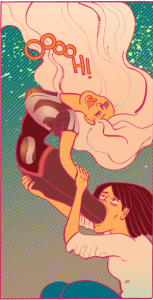 I wanted to ask about the Jane Fonda dream scenes. They’re almost sci-fi; they’re very cool. Are you doing anything different or experimental to play with those dream scenes?
I wanted to ask about the Jane Fonda dream scenes. They’re almost sci-fi; they’re very cool. Are you doing anything different or experimental to play with those dream scenes?
Anything that strikes my fancy. I do try to make them a little bit more art comicky. Meat & Bone is a really straightforward, narrative structure story, but I also have done a lot of art comics and poetry comics in the past. Right now, I’m doing one short story for an anthology for TCAF and a long-ish story called Before the Snows Come that I’m hopefully going to have done for TCAF. They’re all poetry comics that are a little bit more esoteric, a little bit harder to follow, but more visually interesting. I think, in a weird way, when you have a story like that, you can project yourself onto it a bit more than a narrative story with set characters, depending on how it’s handled.
[Poetry comics] are another kind of comic that I enjoy making, but I don’t get to make as much when I’m focused on Meat & Bone, so I like to sneak that in when I can, like dream sequences that are really metaphorical and weird and kind of trippy. That’s just purely for my own amusement.
What do you mean when you say “poetry comic?”
It sort of depends on who’s making them, because a lot of cartoonists are defining their own works and how that is expressed. The first one I did is called Dangerous Cooking. It’s about foods that have sexual or poisonous attributes, and it was actual poems that I’d written. I portrayed them in a sort of wibbly-wobbly, cute comic that was full of these very strange visual plays. Like, this woman grows out of the ground, and she’s actually poisonous mushrooms. This guy eats her and dies, really grossly. It was pretty fun.
This one I’m working on now is a little bit more like a written poem with visual elements, rather than a fully incorporated visual and textual poem. I’ve also seen some that have no words. It’s a pretty loose definition, and mine isn’t necessarily the right definition for everybody on what poetry comics are.
Speaking of other work, you have a story in the Oath Anthology?
I did, yeah, which is about a butch lesbian environmental terrorist who rides a dirt bike and wears a motocross sort of costume as her superhero suit. She’s got moral conflicts about who she’s going to save. She basically has to get involved in this corporate hold-up situation, which is completely against her morals of environmentalism. But it focuses mostly on her and her wife, and how they support each other.
Did you have a story in RAW: A Hannibal/Will Anthology fanzine?
I did. It is kind of a snapshot into Will and Hannibal’s shared mind space at the end of the series, showing what’s actually happening versus showing what’s happening between them emotionally, [but] portrayed by the kitchen, and their views of one another. It was another one where I wanted to be a little more metaphorical and sort of arts-comic about it, so it’s not as much a story-story as it is just a feast of visuals.
Other than conventions, how can fans get their hands on your work?
I have a gumroad for digital downloads, and my StoreEnvy is in hibernation right now, because I’m in the wrong country to mail anything, but that’ll open right before TCAF. My actual novel-novel [Towerkind] is always available through the Conundrum Press website.

